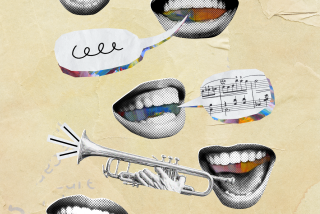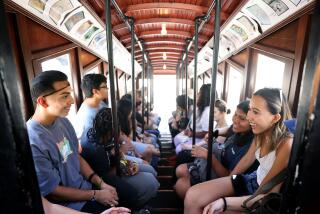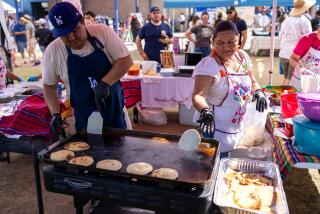Discovering America : History: At Memorial Junior High in Barrio Logan, students learn about what was here before Columbus.
For many schools around the country, this is the year to celebrate the coming of Columbus.
Not in Barrio Logan.
Teachers and other employees at Memorial Junior High fashioned a celebration Wednesday that took a more extensive view of history. New World lesson No. 1: There was nothing new about it when Columbus showed up.
After nine weeks of class preparation, students at the year-round school--84% Latino and with a strong African-American presence--got to check out the lives of Americans who were already here, from the Inuit to the Incas.
It was a hands-on affair.
Some kids rode around on rental llamas, making like Incas in the Andes. Some practiced twirling an Inuit yo-yo: dual spheres of fur and leather used to hone hunting skills.
At one booth, 13-year-old Luis Gutierrez showed other kids how to do as the Kumeyaay Indians once did in San Diego County, placing a pinch of chia seed between the cheek and gum to stave off thirst.
Even aggression was condoned, sort of.
The human sacrifice booth wasn’t attracting many takers, but a few yards away several kids rolled up their sleeves to work off old grudges, reliving the conflict between Aztecs and invading Spaniards in the form of a very mean pillow fight.
“I thought it was really important that we celebrate our native peoples,” said Linda Taggart, a teacher of ninth-grade English who organized the fair. “There’s a lot of commotion about Columbus and the ‘discovery’ of America. But if you really study the history you realize there were thousands of people here before that.
“There were a lot of memos sent back and forth,” she said, “and we decided that we preferred to celebrate the people who were here .”
“At first, they wanted to make it ‘500 Years of America.’ There was some resentment about that,” said Johnny Garza, a physical education teacher. “Especially here in Barrio Logan. But it came out as very educational. It was (these kids’) ancestors who were here already. Now they realize there was something controversial about the ‘discovery’ of America.”
Preparation for the fair, dubbed “Celebrate the Americas,” involved almost every classroom at the middle school--from math and social studies to science and English. Each teacher picked a particular culture and worked its legends, literature and culture into the curricula.
Taggart picked the Aztecs, teaching her students the legend of “La Llorona,” a woman who helped Hernando Cortes find his way across Mexico. When Cortes wanted to take their children back to Spain, she killed them, for fear they would lose their sense of culture.
A similar fear--albeit less hysterical--prompted teachers to push for the celebration. The language spoken most in the schoolyard Wednesday was Spanish. For some Latino students, the day’s events stirred some serious pride.
“It’s great because they’re celebrating La Raza,” said 13-year-old Manuel Altamerano, who moved here from Mexico City seven years ago. He and two friends were dressed in white slacks and shirts, with straw hats and Mexican bandannas around their necks. Altamerano said even the non-Latino kids were getting into it.
“I told them what (Mexicans) dress like and about the Aztec culture,” he said.
“It’s important what somebody is and where they come from,” added Roberto Ramirez, who left Tijuana six years ago.
Jose Ramirez, 11, who came here from Michoacan three years ago, said some of the students at Memorial really need a boost in pride.
“Some are out , and some aren’t,” he said of the Mexican students. “Some like to dress (in traditional clothes). Others have been here, like, 12 years, and they don’t even like to speak of Mexico.”
“I think it makes them more proud, because they know who their ancestors were. And you learn more about your own culture,” said 12-year-old Maria Salaz. She and the rest of her seventh-grade class also learned about the Sioux Indians, including how to do a rain dance.
The event drew in a lot of parent volunteers. Lidia Vallejo’s daughter graduated from Memorial two years ago, but Vallejo has been volunteering at the school since she moved from Mexico City five years ago.
The fair, which featured 29 separate booths, helped smooth tensions between Latino and African-American students, Vallejo said. Wednesday’s events also featured African-American dance and Cajun attractions.
“The most important thing is that it unites the people of the Americas instead of dividing them by countries,” Vallejo said in Spanish. “The Mexican and African-American students have had problems. Now they are mixing, learning about each other’s cultures.”
“I think it’s good to learn about Mexican heritage and Indian cultures,” said Rhea Rhone, a 13-year-old African-American. “I think they should put all of it in, not just Columbus. At this school, first we studied Columbus and the other explorers, and now we’re doing this.”
According to teacher Garza, changing the theme of the celebration was a sensitive matter.
“It was very touchy for some people,” he said. “But it was a good education for some of the teachers, who said, ‘Hey, we were taught in school that America was discovered in 1492.’ Then some Chicano teachers said, ‘Discovered? We were already here.’ ”
In addition to the llamas and the Inuit yo-yos sent down from Alaska for the fair, some other elements were imported. There were the Little Hawks, Native American dancers from the Lakeside School District, and the professional Running Path International, which has performed Native American dances from Chula Vista to France.
“They did a fabulous job here,” said Kim Flying Eagle, a Navajo dancer from Gallup, N. M. “Instead of being closed up, they’re opening up more, to express each other’s cultures.”
Teachers agreed that the event was a success.
“I’ve been here seven years,” social studies teacher Ernesto Bustillos said. “This is the most student participation I’ve ever seen, as well as parents.”
More to Read
Sign up for Essential California
The most important California stories and recommendations in your inbox every morning.
You may occasionally receive promotional content from the Los Angeles Times.











